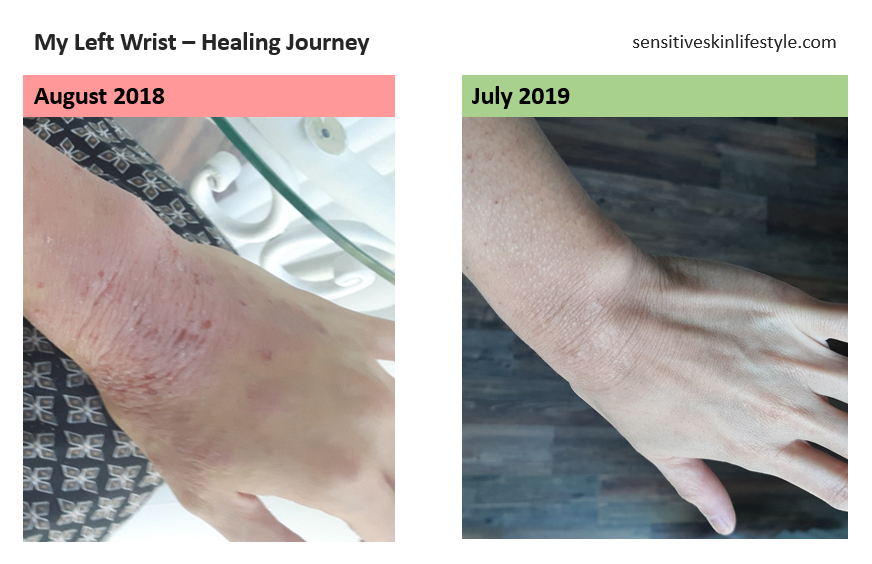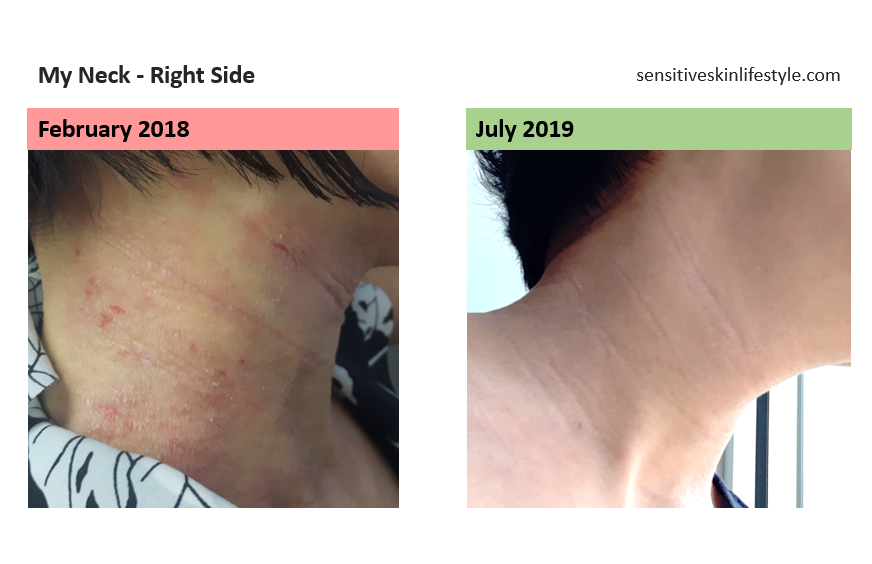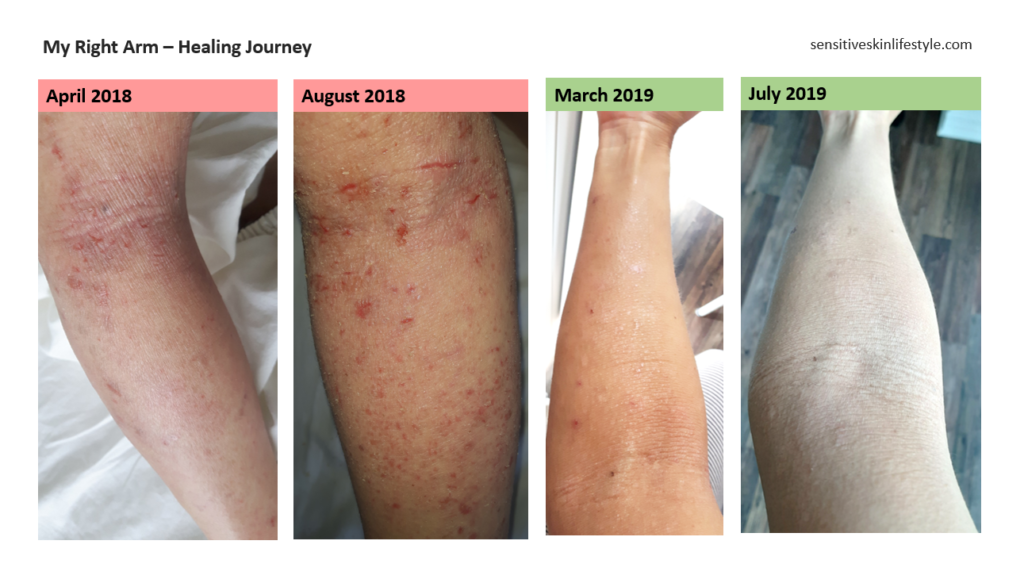My On-going Recovery Journey Part I – Lifestyle Changes
Caution – Some Images Are Graphic: If you don’t like seeing before & after photos of skin, stop scrolling after the quote at the end of this blog post.
Hi Friends!
This week, someone asked me to talk about the journey I’ve taken to come this far in my topical steroid withdrawal (TSW) healing.
My path consisted of much research, discernment, trial & error, so I’ll focus on the key things that collectively helped me recover from the moment I totally stopped corticosteroids on March 2018. The TSW recovery journey lead me from having chronically painful & itchy skin that left me totally bed-ridden to a happy state where 80% of my skin is clear and intact and I am able to sleep well at night. During this time, I did not use any immunosuppressants or biologic drugs (i.e. Dupixent).
Just to be clear, I still experience itching & eczema symptoms. But I am no longer bed ridden, nor covered in broken skin. Though I can do more activities, I am prone to flare ups if I don’t proactively manage my stress and lifestyle.
I have split this into 2 blog posts:
- My On-going Recovery Journey Part I – Lifestyle Changes
- My On-going Recovery Journey Part II – Treatment Programs
Before I start, I want to note that each person’s healing journey is unique because our bodies, triggers and environments are different. I just wanted to provide a little insight into my life as an encouragement to others on how, after I decided to my recovery as a priority, my skin started to heal.
My On-going Recovery Journey Part I – Lifestyle Changes
Staying Clean, Cool, Comfortable, Calm & Rested.
- Physical rest: During my worst time, I had no choice but to give my body the rest it needed. For a long while, I wasn’t able to leave the home except for necessities (groceries, medical appointments etc). It was at this time I realized rest was an important factor for my healing.
- Changed sheets, bedding & duvet covers to 100% cotton: Polyester in my sheets irritated my skin, so I changed over to a 100% cotton bedsheets – more on this below.
- Keep myself and my environment cool, clean & dry: I vacuum a lot to reduce dust and keep the bathroom clean & dry at all times. After showering, I now always blow dry my hair completely. This really improved my comfort when I go to sleep. Damp hair is both uncomfortable and breeds bacteria growth – which can cause skin inflammation.
- Daily clean bed sheet commitment: I wash my bed sheets, pillow cases and flat sheet every day in high heat wash & dry. I have 2 sets to alternate daily. IKEA has some reasonably priced 100% cotton sheets. Many people with eczema have been tested positive for dust mite allergy – I am one of them – hence the reason for this.
- Daily liquid in-take: I make sure I am hydrated. In particular, I drink:
- 2 L of filtered water or celery drink (celery blended with filtered water)
- A glass of cucumber drink (1/3 English cucumber blended with filtered water)
- Elimination diet: Everyone has different sensitivities & allergies – Lots of contradictory information online. For me I saw great improvement in completely cutting out all processed & packaged foods, gluten, dairy, eggs, sugar (including honey/maple syrup for a long time), MSG, yeast, all seafood except fish that are low in histamine levels, beef, pork, oranges, capsicum, kale, bananas, eggplants, mushroom, dates, dried fruit, nuts (except macadamia) tomatoes. I eliminated them all at the same time. In addition, I follow a low histamine diet and the only seasonings I use are coconut soy sauce substitute, salt, herbs, dried herbs & black pepper.
- Declutter my life: Living space, physical possessions, commitments (family, social, community), draining or negative friendships. The purpose of this is to maximize physical comfort & minimize stress.
- Set personal boundaries and self care: I say ‘no’ alot and try not to commit to anything I am not ready for. I communicate honestly on things that I’m not comfortable doing and only provide the minimum amount of information that the other party needs to know. On my good days, I try doing things that provide enjoyment – such as going on a solo-date by myself 🙂
- Build a support system: For me, this consists of my husband, family members, a few close friends, medical team – family doctor (and other specialists), psychologist, church and social workers. All of these people are aware of my recovery goals & what I was (and still am) going through. They understand what I am able & not able to do, and are supportive, sensitive & understanding when I am unable to meet up or attend something. In my case, my employer was understanding to my situation, which was a relief.
- Protected my skin – clothing:
- Fibre Content: I only wear clothes consisting of cotton, Tencel/lyocell or a combination of the two. I have a small allowance for spandex/elastane in leggings or underwear. I found this to really make a difference – I experienced true comfort and can’t go back to polyester, wool, acrylic, cashmere etc. Some fibres can irritate sensitive skin.
- Fabric Finish/Type: Cotton doesn’t automatically mean comfort. Pay attention to the clothing finish/feel. Jersey knit, ribbed, fleece, pique, demin, woven – they all make a difference on how it feels on your skin. Tight clothing can also cause discomfort.
- Long Sleeves, Turtle necks, scarves, leggings, toques, head bands: As I have a weakened skin barrier, I use clothing and accessories to protect my eczema affected areas from dust and invisible environmental allergens. This reduces my flare ups and it’s also harder to scratch when you have something protecting it.
- During wintertime, I use these accessories to help protect my skin from the dry winds and winter environment. It also provides a layer of comfort between my skin and the winter jacket. I still try to wear long sleeves on hot days – so I have long sleeve shirts made of thinner cotton/lyocell material.
- Fibre Content: I only wear clothes consisting of cotton, Tencel/lyocell or a combination of the two. I have a small allowance for spandex/elastane in leggings or underwear. I found this to really make a difference – I experienced true comfort and can’t go back to polyester, wool, acrylic, cashmere etc. Some fibres can irritate sensitive skin.
- Moisturizers, hand creams, soaps & shampoo: Less is more. I tried coconut oil, manuka honey, beef tallow etc, but the natural stuff didn’t work for me in terms of comfort nor the improvement of symptoms. In some cases, it actually caused flare ups. On the other hand, the mainstream products seems a little too strong for my skin – causing my skin to dry out or feel too “tight”.
I read product reviews and research ingredients, but because everyone’s skin is different, I sometimes just asked for samples to see if there was any negative reactions.
One lesson I learned: Once you found something that works – Stick to it.
Also, I made sure to NOT over moisturize when I apply cream. Greasy skin does not feel comfortable and can cause me to scratch it more. - Keep my hair short: I feel airy, light & comfortable. This small act makes a huge immediate difference in comfort.
- Constantly identify (and test) for flare-up triggers & proactively avoid/eliminate them: Food, Environmental (i.e. heat, pollen, dust) & Situational Factors (i.e. stress, anxiety).
- Shift my perspective & changed my mindset: I used to think that I can start living life again when I am fully healed from this condition and often felt trapped. But when I started accepting my health condition as it is, and re-evaluated life – I started living, like I never had.
These are the key lifestyle changes that made a difference in my skin recovery to-date, life, physical & mental well-being. I am happy.
Lifestyle changes aren’t easy – its one of those things where I do my best and try not to beat myself up when I’m unable to follow through. Tomorrow is a new day and just try again. One day, I woke up realizing that I am living it.
Each of the aforementioned steps could be its own blog post in itself – if there is anything you’d have further questions or would like me to dive deeper – Leave a comment below or let me know.
What have you tried so far that worked or didn’t work? Leave a comment below – as while everyone is different, the sharing of your personal journey and experience will benefit and encourage the TSW & eczema community.
In my next post, My On-Going Recovery Journey Part II – Treatment Programs, I will share the treatment programs that I went through during this period (March 2018 to Present) that were impactful in my recovery. Stay tuned!
Wishing all of us complete restoration of our skin & healths. This is journey is a blessing in disguise!
-Catherine

Disclaimer: All the content found on this website and blog is provided for informational purposes only and is not intended to replace proper medical advice. See here for more details.
Some glimpses of my recovery





